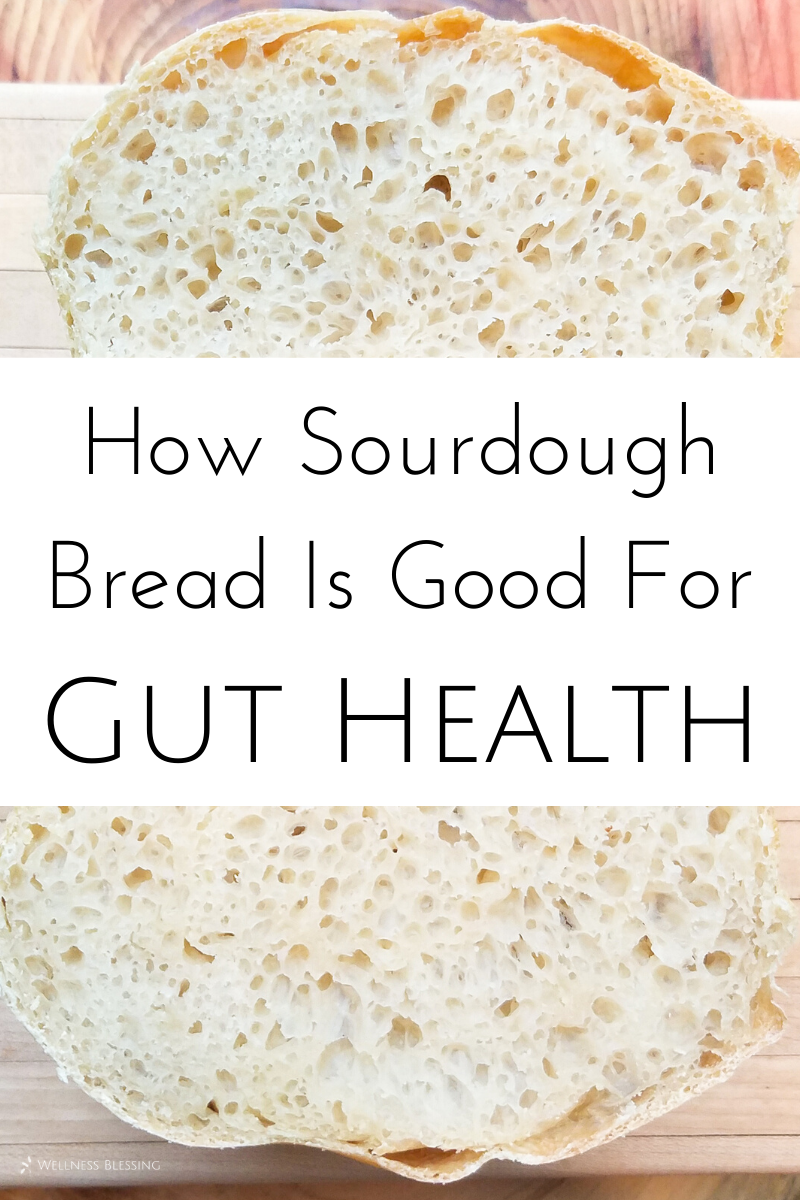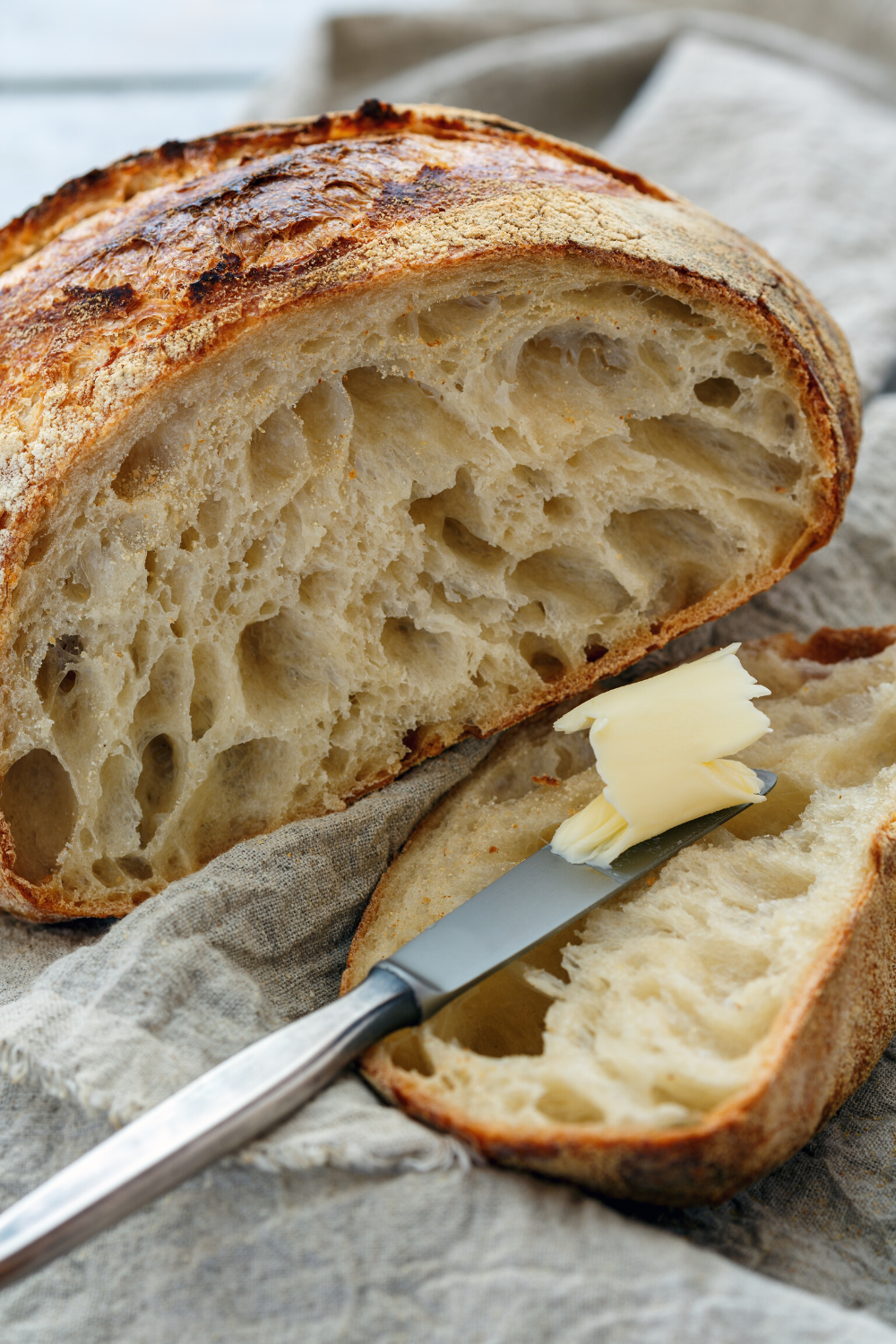How Sourdough Bread is Good for Gut Health
There is a sourdough bread revival happening.
Sourdough bread baking is the original way of making leavened bread, used for thousands of years, long before the invention of commercial yeast.
In addition to being the traditional way of making soft, fluffy, and delicious bread, it’s also beneficial for gut health, boosts the nutritional value of the grains, and reduces digestive issues related to commercial bread baking practices.
In recent times, wheat has gotten a bad rap, and gluten-free has become a massive trend.
However, wheat is one of the world’s most important staple foods, that is intricately linked with the history of humanity, and wheat itself is not bad.
Modern farming techniques have changed the culture of wheat and bread.
Bread was originally all heirloom organically-grown grains, milled in small batches, and fermented before being baked.
Now conventional bread production is an industrial operation of mono-crops with pesticides, milled in huge factories with added synthetic vitamins, and cooked with commercial yeast and a multitude of unhealthy and genetically-modified additives including sugar, soy flour, and preservatives.
Today, people are starting to realize that maybe it’s not wheat that’s bad for us, it’s highly processed bread that is causing digestive problems.
Thus, the sourdough revolution that’s bubbling up in kitchens around the world is a welcome reclaiming of heritage bread baking and digestive wellness.
The Amazing DNA of Wheat
Wheat has an incredibly complex genome.
The human genome contains 3 billion DNA letters.
The wheat genome is over 5 times the size of the human genome, containing an astonishing 17 billion DNA letters.
It was only recently that scientists were able to crack the code on the incredibly huge genome sequencing of wheat due to the enormous amount of data that they needed to sift through.
The wheat genome is a hexaploid genome, with 6 copies of its 7 chromosomes, making 42 chromosomes total.
It’s so large because hexaploid bread wheat today is a hybridization of 3 ancient grasses, including einkorn and two wild wheats.
These three ancient grasses become cross-pollinated in the Fertile Crescent a long time ago, and as people gathered, cultivated, and domesticated the best grains from the grasses, wheat as we know it became developed.
The History of Sourdough
Sourdough is the oldest form of leavened bread, created by harnessing the wild yeast in the air through a long slow fermentation of flour and water to create a levain.
This levain, also known as sourdough starter, is added to the rest of the bread ingredients to create a natural rise and light airy bread.
A portion of the starter is reserved and fed with more flour and water to keep it active and get it ready for the next day’s baking.
Today, we can store an active sourdough starter in the fridge and just take it out and feed it when desired.
Prior to sourdough, people only ate unleavened flatbreads.
Surely the discovery of naturally yeasted dough was a delight to ancient bakers for it created a much lighter bread as well as added flavor, and dramatically expanded the possibilities of bread recipes.
There is evidence of sourdough bread baking as early as Ancient Egypt, as it was carefully recorded through ancient wall paintings and samples of ancient Egyptian bread yeast have been gathered and even baked with today.
On the Giza plateau, remains of bakeries and an ancient pottery dumping ground have been found, with half-a-million shards of broken bread molds, indicating that sourdough bread was the main food that fueled the building of the pyramids.
Bread was the heart of the Ancient Mediterranean diet, baked every day, and eaten at every meal.
It was not only sustenance, but it was also a utensil, used to dip in olive oil, hummus, or stew, and to wipe clean the bowls of shared food.
Today, the Mediterranean diet is heralded as the healthiest cuisine for gut health.
The ancient diet of the island of Crete is considered to be the epitome of healthy Mediterranean cuisine, and they eat three times more bread than the average American.
When the Ancient Roman city of Pompeii was destroyed by the eruption of Mt. Vesuvius in 79 A.D., it preserved the buildings and streets of the city, along with their bakeries.
Archeologists have uncovered 33 community bakeries in the city of Pompeii, which indicate that the bakery was a vital hub of city life.
Sourdough bread has an ancient history that is well-founded upon taste and nutrition.
Sourdough and Gut Health
The natural fermentation of sourdough bread makes it rise above the quality of modern yeasted bread, not just because of the tangy, slightly sour flavor that is beloved by so many, but also because it imparts a wide range of health benefits.
Sourdough starter contains the wild yeast from the environment that it is brewed in, as well as from the flour it is made of.
Studies of sourdough starter from all over the world show that each one has a unique flavor and microbial profile based upon the baking environment.
Very fascinating research also shows that not only does the baker influence the culture of the sourdough starter, but that baking with sourdough culture actually changes the microbiota of the baker’s hands too!
One of the most beneficial wellness aspects of enjoying sourdough is that it supports gut health.
The slow fermentation of sourdough helps to break down phytic acid in the flour, which then allows more nutrients to become absorbed when we eat the sourdough bread.
It also predigests the grains, which eases the job our digestive system needs to do to break down the bread and extract nutrition and energy from our food.
The fiber from sourdough bread helps to nourish the good microbiota in our guts to support digestive health.
Supporting our gut health helps to reduce inflammation in the body, support weight loss, and boost our mood.
For optimal health benefits, be sure to make your own sourdough or to read the ingredients when purchasing to ensure it is real sourdough bread.
Many breads today labeled “sourdough” actually have additional commercial yeast added to them so that they bake quicker.
It’s actually a great educational experience to peruse the bread aisle at your local grocery store and read all the ingredients listed on the bags of bread.
It’s eye-opening to see how many breads in the U.S. today have sugar, soy, synthetic vitamins, and preservatives included in their long-list of ingredients.
As I’ve learned how to make sourdough bread at home, my list of ingredients for my favorite loaf is very simple, it’s just flour, water, and salt.
There are so many uses and variations for sourdough baking too. The possibilities are endless from pancakes to pain au levain.
Plus, nothing beats breaking a loaf of fresh-baked sourdough bread with friends and family.
Do you have a sourdough starter bubbling in your kitchen?
If so, I hope this article inspires you to appreciate the amazing DNA, history, culture, and health benefits of sourdough baking.
If not, when you are buying bread at the grocery store, I hope this inspires you to read the labels and reach for the good sourdough loaves to bring home with you.
Also, please support your local sourdough bakers and small bakeries that are keeping this art alive.
Here’s an entertaining and educational video from Proof Bakery in Arizona, that is going viral right now, and shows just how much work, skill, and art goes into baking sourdough bread for communities to enjoy:
Artisan Sourdough Bread Baking Process from Start to Finish Video
Yes, this video is an hour-long, but as one commenter wrote, “I was like: I’m not watching an hour of bread making. Then I watched an hour of bread making.” To which someone else replied, “Ha, I'm watching it AGAIN!”
My entire family sat watching this video, and everyone was fascinated including our 3-year-old.
There is something mesmerizing and meditative about the art of bread making.
Luckily, this ancient art of sourdough is being brought back into many homes today as more people are making their own bread the traditional way.
Many blessings,
Kara Maria





